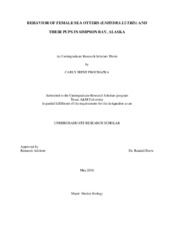| dc.description.abstract | Being altricial mammals, sea otter pups need their mother’s care in order to survive. As an endangered, keystone species, it is important to understand the relationships between female sea otters and their pups, including how the female cares for herself while also allotting a majority of her energy to her pup. Research on sea otter female-pup relationships in Simpson Bay, Alaska is limited. This research will look at the relationship between female-pup pairs to test the hypothesis that as pups mature they become more independent and less attention and energy input from the female is needed. This research will focus on three questions:
1) What are the activity budgets of female and pup sea otters at different pup categories?
2) What are the distances between female-pup pairs at different pup categories?
3) What is the foraging dive time for the female sea otter at different pup categories?
Sea otters will be observed in female-pup pairs from a boat in Simpson Bay, Alaska using binoculars. At the completion of this research, a better understanding will be gained as to how the female sea otter meets her demands and her pup’s demands as the pup grows. | en |


